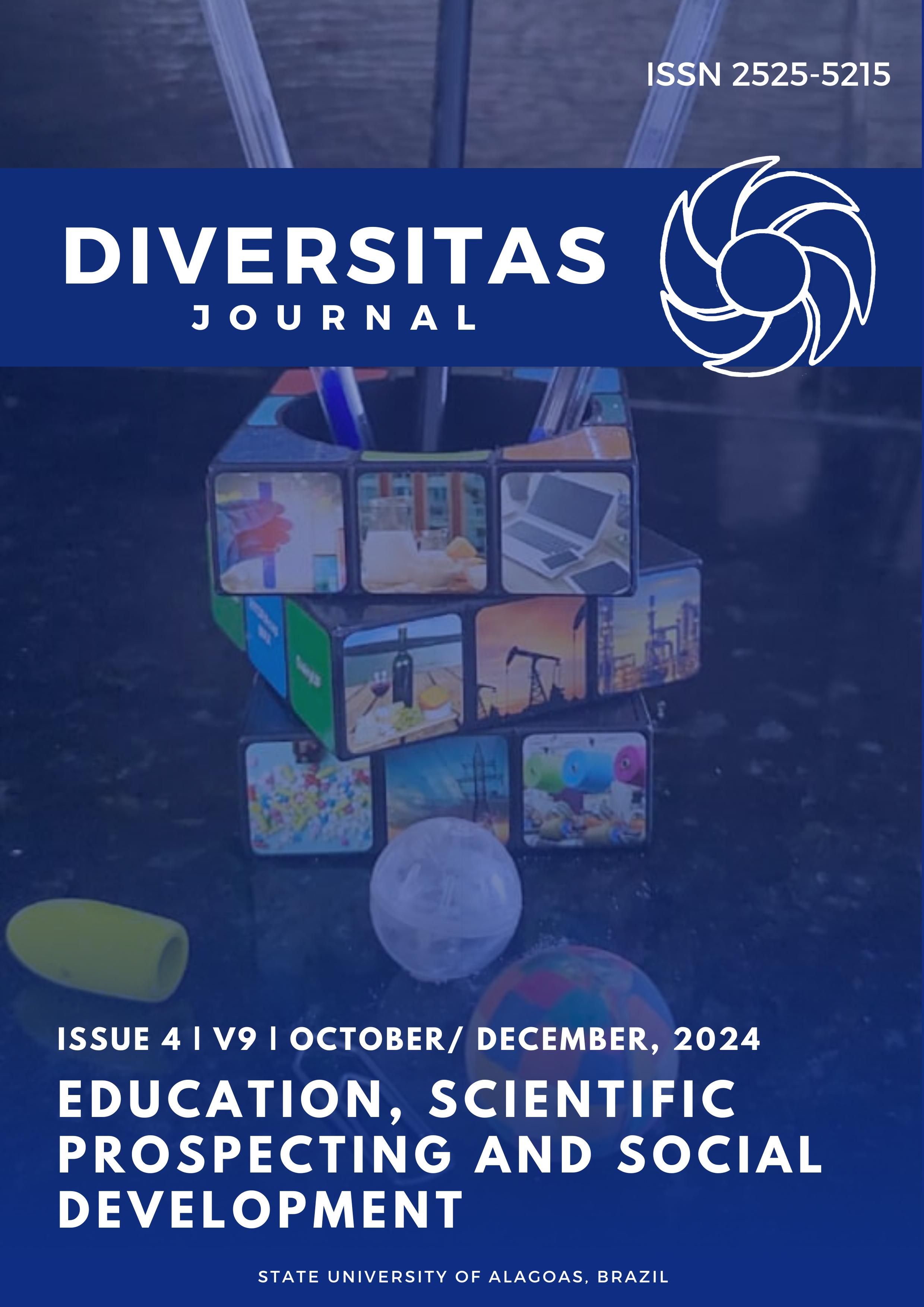Lista de verificação de samambaias no Monte. Mariveles, Bataan, Filipinas
DOI:
https://doi.org/10.48017/dj.v9i4.3134Palavras-chave:
Elevação, Inventario, Plantas VascularesResumo
Uma lista de verificação de espécies de samambaias no Monte Mariveles, Bataan foi fornecida em duas trilhas, Tarak Ridge e Pantingan Peak de 400 msnm a 1000 msnm com informações sobre suas formas de crescimento, endemicidade e status de conservação. Os espécimes coletados foram identificados e avaliados com base em seu status de conservação. Havia 28 táxons e 20 gêneros em 14 famílias de samambaias observadas no Monte Mariveles Bataan. Entre as 14 famílias, Aspleniaceae tem as espécies mais numeradas, consistindo de 5 táxons. Existem 20 táxons de samambaias, 14 gêneros em 10 famílias que são encontrados em Tarak do Monte Mariveles, enquanto 11 táxons e 9 gêneros em 10 famílias foram registrados no Pantingan do Monte Mariveles. Mais samambaias foram observadas no Rio Papaya em Tarak e de 800 a 1000 msnm em Pantingan. As florestas de altitude média tiveram a maior riqueza máxima de samambaias. Ela resulta de alta umidade, precipitação e temperaturas moderadas. A forma de crescimento das samambaias coletadas é principalmente epífita. Com base em seu status de conservação, duas espécies são de menor preocupação (LC), são Pteridium aquilinum e Dicranopteris linearis, enquanto Angiopteris evecta de Marattiaceae foi considerada como Outra espécie ameaçada (OT).
Métricas
Referências
Acebey, A. R., Krömer, T., & Kessler, M. (2017). Species richness and vertical distribution of ferns and lycophytes along an elevational gradient in Los Tuxtlas, Veracruz, Mexico. Flora, 235, 83-91.
Alcala, A. A., Angeles, M. D. D., & Inocencio Jr, E. B. (2019). Fern species diversity across various land use types of Mt. Makiling, Luzon Island, Philippines. Biodiversitas Journal of Biological Diversity, 20(9). https://doi.org/10. 13057/biodiv/d200902
Amoroso VB, Coritico FP, Fritsch PW. 2016. Species richness and conservation status of ferns and lycophytes in Mt. Hamiguitan Range Wildlife Sanctuary, Davao Oriental, Philippines. Philippine Journal of Science 145: 127–137.
Barcelona JF, Nickrent DL, Lafrankie JV, Callado JRC, Pelser PB. 2013. Co's Digital Flora of the Philippines: plant identification and conservation through cybertaxonomy. Philippine Journal of Science 142(special issue): 57–67
Catapang MVL, Reyes PJD, Medecilo MP (2012) Factors influencing species diversity of ferns in Mt.
Makulot, Cuenca, southern Luzon, Philippines. In: 2nd international conference on environment and industrial innovation; 2-3; Hongkong, China. IACSIT Press, Singapore. IPCBEE, 35, 98–102
Hassler, M., 2004–2021. World Ferns: Synonymic Checklist and Distribution of Ferns and Lycophytes of the World. Version 12.3. www.worldplants.de/ferns/.
Hassler, M. (2023). World Ferns. Synonymic Checklist and Distribution of Ferns and Lycophytes of the World. Version 16.1; last update June 16th, 2023. Retrieved June 23, 2023, from www.worldplants.de/ferns/
IUCN (2024). The IUCN Red List of Threatened Species. Version 2023-1. https://www.iucnredlist.org>nting Office, Singapore. 643
Kessler, M. (2010). Biogeography of ferns. In: Fern Ecology. Mehltreter K, Walker L, Sharpe J eds. Cambridge: Cambridge University Press. 22–60. https://doi.org/10.1017/CBO9780511844898.003
Khine, P. K., Kluge, J., Kessler, M., Miehe, G., & Karger, D. N. (2019). Latitude‐independent, continent‐wide consistency in climate–richness relationships in Asian ferns and lycophytes. Journal of Biogeography, 46(5), 981-991.
Kluge, J., Kessler, M., & Dunn, R. R. (2006). What drives elevational patterns of diversity? A test of geometric constraints, climate and species pool effects for pteridophytes on an elevational gradient in Costa Rica. Global ecology and biogeography, 15(4), 358-371.
Kramer, K.U., & Viane, R., (1990). Aspleniaceae. In: Kubitzki, K., Kramer, K.U., Green, P.S.(Eds.), The Families and Genera of Vascular Plants, 1, Pteridophytes and Gymnosperms. Springer, Berlin, 52–57
Kreft, H., Jetz, W., Mutke, J., & Barthlott, W. (2010). Contrasting environmental and regional effects on global pteridophyte and seed plant diversity. Ecography, 33(2), 408-419.
Lin, Y.-X., & Viane, R., (2013). Aspleniaceae. In: Wu, Z.-Y., Raven, P.H., Hong, D.-Y. (Eds.), Flora of China. 2–3. Science Press/ Missouri Botanical Garden Press, Beijing and St. Louis, pp. 267–316.
Mabberley, D. J. (2008). Mabberley's Plant-Book: A Portable Dictionary of Plants, Their Classifications, and Uses (third ed.), Cambridge University Press, Cambridge
Ohlsen, D. J., Perrie, L. R., Shepherd, L. D., Brownsey, P. J., & Bayly, M. J. (2015). Phylogeny of the fern family Aspleniaceae in Australasia and the south-western Pacific. Australian Systematic Botany, 27(6), 355-371. 1 http://dx.doi.org/10.1071/SB14043
Pelser, P.B., J.F. Barcelona & D.L. Nickrent (eds.). 2011 onwards. Co's Digital Flora of the Philippines. www.philippineplants.org
POWO. (2023). Plants of the World Online. Facilitated by the Royal Botanic Gardens, Kew. http://www.plantsoftheworldonline.org/
Qian, H., Kessler, M., Zhang, J., Jin, Y., & Jiang, M. (2023). Global patterns and climatic determinants of phylogenetic structure of regional fern floras. New Phytologist, 239(1), 415-428.
Qian, H., Kessler, M., Deng, T., & Jin, Y. (2021). Patterns and drivers of phylogenetic structure of pteridophytes in China. Global Ecology and Biogeography, 30(9), 1835-1846.
Smith AR, Pryer KM, Schuettpelze E, Korall P, Schneider H, Wolf PG. 2008. Fern classification. In: Biology and evolution of ferns and lycophytes. Ranker TA, Haufler CH eds. Cambridge, United Kingdom: Cambridge University Press, 417–446
Suissa, J. S., Sundue, M. A., & Testo, W. L. (2021). Mountains, climate and niche heterogeneity explain global patterns of fern diversity. Journal of Biogeography, 48(6), 1296-1308.
Suryana, S., Iskandar, J., Parikesit, P., & Partasasmita, R. (2018). Ethnobotany of tree ferns in pasir menyan hamlet, Sukamandi village, Subang, West Java, Indonesia. Biodiversitas Journal of Biological Diversity, 19(6), 2044-2051.
Umair, M., Hu, X., Cheng, Q., Ali, S., & Ni, J. (2023). Distribution patterns of fern species richnessalong elevations the Tibetan Plateau in China: regional differences and effects of climate change variables. Frontiers in Plant Science, 14, 1178603.
Vidallon, S. L., & Arriola, A. H. (2021). A Preliminary Checklist of Vascular Plants in Tarak Ridge Trail of Mt. Mariveles, Bataan, Philippines. Biodiversity Journal, 12(4), 811-823.
Weigand, A., Abrahamczyk, S., Aubin, I., Bita‐Nicolae, C., Bruelheide, H., I. Carvajal‐Hernández, C., ... & Kessler, M. (2020). Global fern and lycophyte richness explained: How regional and local factors shape plot richness. Journal of Biogeography, 47(1), 59-71.
Downloads
Publicado
Como Citar
Edição
Seção
Licença
Copyright (c) 2024 Shiela Lucero Vidallon, Axel Havana Arriola

Este trabalho está licenciado sob uma licença Creative Commons Attribution 4.0 International License.
O periodico Diversitas Journal expressa que os artigos são de unica responsabilidade dos Autores, conhecedores da legislação Brasileira e internacional. Os artigos são revisados pelos pares e devem ter o cuidado de avisar da possível incidencia de plagiarismo. Contudo o plagio é uma ação incontestavel dos autores. A Diversitas Journal não publicará artigos com indicios de Plagiarismos. Artigos com plagios serão tratados em conformidade com os procedimentos de plagiarismo COPE.
A violação dos direitos autorais constitui crime, previsto no artigo 184, do Código Penal Brasileiro:
“Art. 184 Violar direitos de autor e os que lhe são conexos: Pena – detenção, de 3 (três) meses a 1 (um) ano, ou multa. § 1o Se a violação consistir em reprodução total ou parcial, com intuito de lucro direto ou indireto, por qualquer meio ou processo, de obra intelectual, interpretação, execução ou fonograma, sem autorização expressa do autor, do artista intérprete ou executante, do produtor, conforme o caso, ou de quem os represente: Pena – reclusão, de 2 (dois) a 4 (quatro) anos, e multa.”


















